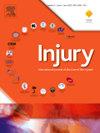Trends and determinants of falls: A generalized estimating equations modelling approach using serial data from the geelong osteoporosis study
IF 2.2
3区 医学
Q3 CRITICAL CARE MEDICINE
Injury-International Journal of the Care of the Injured
Pub Date : 2025-03-24
DOI:10.1016/j.injury.2025.112298
引用次数: 0
Abstract
Background
With Australia's aging population, the incidence of falls is expected to rise. The proportion of adults aged ≥65 years is projected to increase from 15 % in 2017 to 22 % by 2057, highlighting the growing need for effective fall prevention measures. Therefore, this study aimed to assess fall trends and determinants using repeated follow-up data from a population-based study.
Methods
This study utilized data from the Geelong Osteoporosis Study (GOS) to analyse fall trends in men and women. Men's data were collected at baseline (2001–2006; n = 1533), 5 years (2006–2011; n = 968), and 15 years (2016–2021; n = 627), while women's data were from 6 years (2001–2003; n = 1014), 10 years (2004–2008; n = 1098), and 15 years (2011–2014; n = 844). Falls data, self-reported for the past 12 months, were age-standardised to the Australian population. Data included self-reported prior fractures, medications, comorbidities, alcohol use, and smoking, along with measured anthropometrics, muscle strength, biochemical tests, and imaging. A multivariable Generalised Estimating Equation model identified fall determinants, reporting adjusted odds ratios (AORs) and 95 % confidence intervals.
Results
In men, the age-adjusted prevalence of falls declined over time, while in women, it initially dropped by 4.2 % before a slight 0.6 % increase. After adjusting for confounders, each additional year of age raised the fall risk by 1 % (AOR = 1.01, 95 % CI: 1.00–1.02). Women had a 52 % higher likelihood of falling than men (AOR = 1.52, 95 % CI: 1.22–1.88). Diabetes increased the risk by 69 % (AOR = 1.69, 95 % CI: 1.23–2.31), while a 1 N/kg increase in hip flexion strength lowered the risk by 3 % (AOR = 0.97, 95 % CI: 0.95–0.99).
Conclusion
Men experienced a steady decrease in fall prevalence over time, whereas women displayed a more intricate trend, with falls initially declining before subsequently rising, following a polynomial pattern. The key predictors of falls included age, sex, diabetes and hip flexion strength. Policies should prioritize tailored fall prevention, strength training, and diabetes care integration.
求助全文
约1分钟内获得全文
求助全文
来源期刊
CiteScore
4.00
自引率
8.00%
发文量
699
审稿时长
96 days
期刊介绍:
Injury was founded in 1969 and is an international journal dealing with all aspects of trauma care and accident surgery. Our primary aim is to facilitate the exchange of ideas, techniques and information among all members of the trauma team.

 求助内容:
求助内容: 应助结果提醒方式:
应助结果提醒方式:


